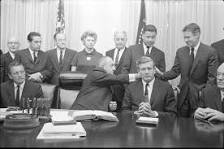Kerner Report relevancy for 1960s Trenton

The problem:
Trenton and other major cities during the 1960s went through a whirlwind of emotions for all that lived through the time. The racial tensions were high, and blood was boiling. The National Advisory Commission of Civil Disorders or the Kerner Report was put in effect to establish and expand Federal Programs to make amends with the racial divide and deal with the riots that were taking place.
The excerpt:
President Lyndon Johnson formed an 11-member National Advisory Commission on Civil Disorders in July 1967 to explain the riots that plagued cities each summer since 1964 and to provide recommendations for the future. The Commission’s 1968 report, informally known as the Kerner Report, concluded that the nation was “moving toward two societies, one black, one white—separate and unequal.” Unless conditions were remedied, the Commission warned, the country faced a “system of ’apartheid’” in its major cities. The Kerner report delivered an indictment of “white society” for isolating and neglecting African Americans and urged legislation to promote racial integration and to enrich slums—primarily through the creation of jobs, job training programs, and decent housing. President Johnson, however, rejected the recommendations. In April 1968, one month after the release of the Kerner report, rioting broke out in more than 100 cities following the assassination of civil rights leader Martin Luther King, Jr. In the following excerpts from the Kerner Report summary, the Commission analyzed patterns in the riots and offered explanations for the disturbances. In 1998, 30 years after the issuance of the Report, former Senator and Commission member Fred R. Harris co-authored a study that found the racial divide had grown in the ensuing years with inner-city unemployment at crisis levels. Opposing voices argued that the Commission’s prediction of separate societies had failed to materialize due to a marked increase in the number of African Americans living in suburbs. (Partial summary of the Kerner Report, the full one can be found here).
Of the 11 member commission, one of the surviving members was able to speak out about the commission and his hopes on society still. Sen. Fred Harris of Oklahoma still has hope after 50 years, saying ” poverty and structural racism are still flaming racial tensions today, even as the United States becomes more diverse.” Even though the world is diverse, racism is still happening all across the country as an unsettling level.
Prior to the Kerner Report:
Trenton was planning to have renovations for a new shopping center in the Downtown area. As many know, Trenton is one of many food deserts, not having more than one supermarket in the whole city. The $20 million renovation that would have occurred would have included a department store, a 2,000 car parking area, 15-story motor hotel, and an air conditioned mall.
The New York Times put this in the paper on August 21st, 1966 with a headline of “Trenton Pushing Shop Mall Plans“. Unfortunately, the shopping center never came and Trenton soon had the race riots a year later.


